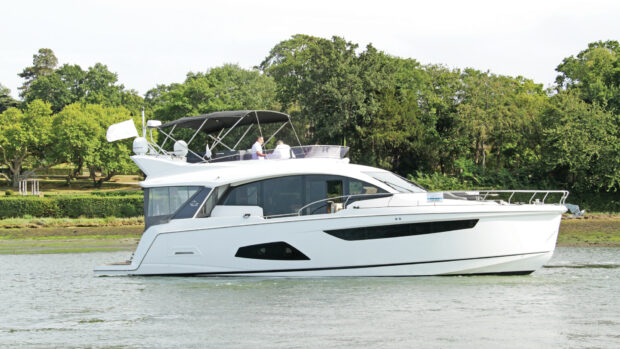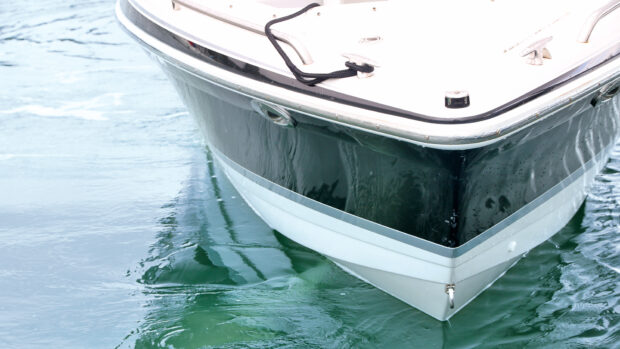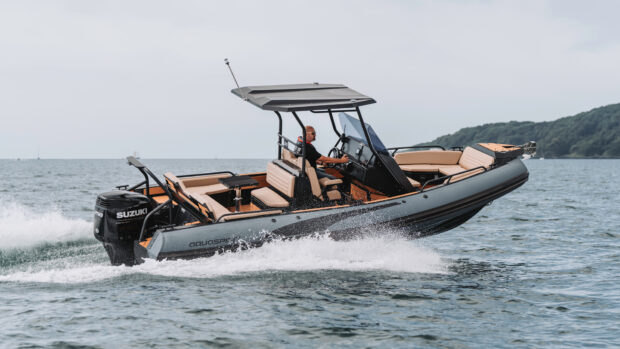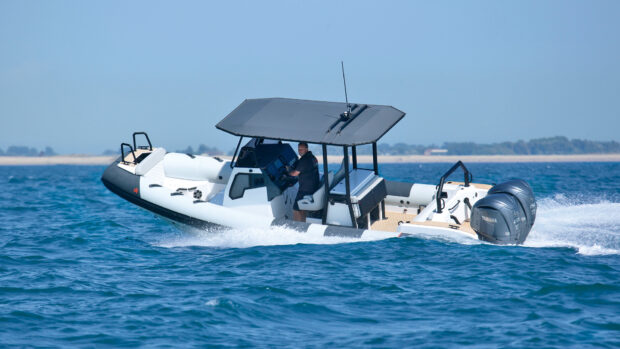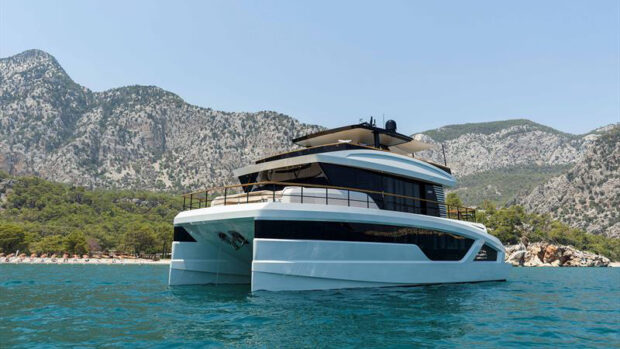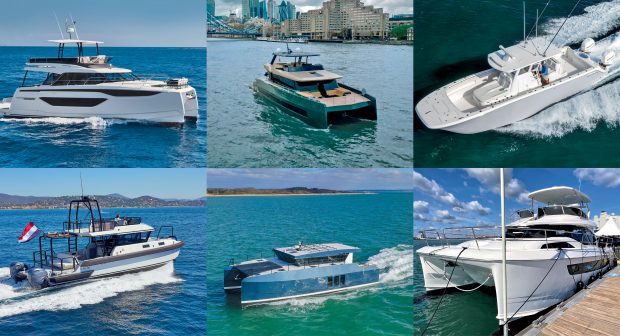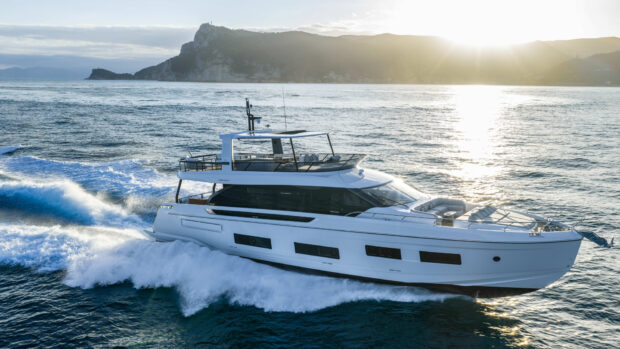Pershing has built some very cool boats over the 40 years it has been in business, but the new Pershing GTX70 is about broadening its appeal to confident owner-drivers
Pershing has built some very cool boats over the 40 years it has been in business. From the outrageous jet-engined Pershing 70 of the 1990s to the lavish 140 superyacht of recent years, they have all been sleek, powerful, macho machines that positively demand attention, from the skipper as much as guests and onlookers.
A bit like the Ferraris and Lamborghinis of the 1980s and ’90s, you needed to know what you were doing to get the best from them, particularly the sensitive early surface drive craft, which required careful trimming at speed and a cool head and steady hand when berthing.
The launch of the new GTX range of sportsbridge boats in 2023 was as much about demystify the business of driving a Pershing as it was about broadening its appeal. Like the Lamborghini Urus and Ferrari Purosangue, you could now own one without having to sacrifice space and comfort on the altar of performance. You could also drive one without needing hours of tutoring.
Admittedly, the original GTX116 was too big for most owners to handle on their own, even if they had the necessary qualifications, but the GTX80 with its Volvo IPS-1350 drives and joystick controls was a perfectly viable option for a confident owner driver. This new GTX70 makes it even more accessible.
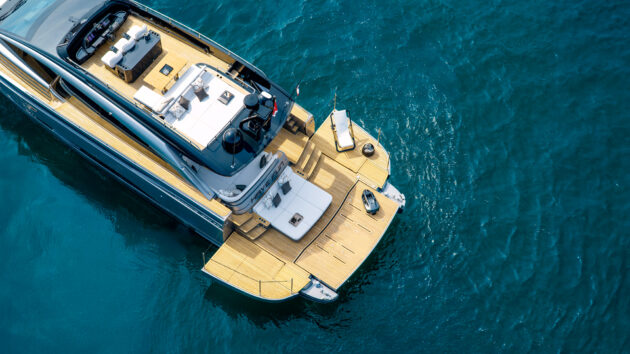
Want the kudos of owning a Pershing without the daunting size and complex drivability? Meet the new GTX70…
With a starting price of €4.2m, we’d hardly call it democratising Pershing ownership but it certainly makes it a less daunting prospect for those with deep enough pockets. The big question, however, is whether in opening up Pershing to a broader spectrum of potential buyers, it has also lost some of the magic and mystique which made its early boats so desirable.
It’s one thing to make a 116ft sportsbridge look sleek and sexy when you’ve got all that length to play with, it’s quite another when you’re trying to pack an extra deck onto something with an LOA of 71ft 5in.
So hats off to the Ferretti Group’s product committee (headed by Piero Ferrari, no less) and Vallicelli Design for managing to pull it off with such style. Thanks to its distinctive snub nose, flowing profile and familiar silver and black colour scheme, the GTX70 is unmistakably a Pershing. And just to ensure it stays that way, you can order it in any colour you like so long as it is one of four approved shades of grey!
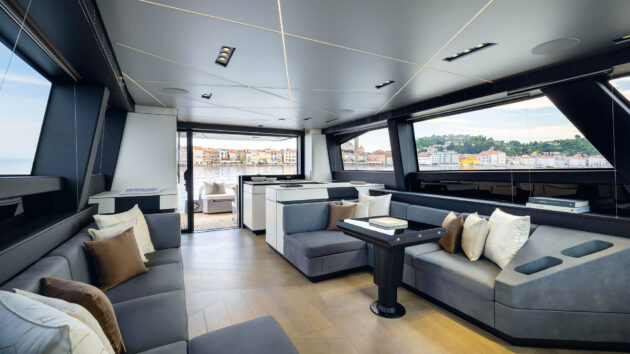
The lack of side decks make for a wider saloon than normal with some lovely design touches – note the criss-cross lighting and deck boards
Shades of Grey
To maintain that lean look, the sportsbridge has been recessed into the roofline and fitted with low-level furniture, a stubby aeroscreen and an elegant black radar mast set as far back as possible. Despite this, it’s actually a very useable space with a proper dinette, wet bar and three-person helm station as well as the ubiquitous sunbed. But the best example of how far they’re prepared to go to preserve the GTX70’s looks and weight distribution is the beautiful carbon-fibre bimini frame that drops down into a well in front of the helm.
It’s such an elegant piece of engineering, we’d leave it up all the time just to show it off. Talking of engineering, the way the hydraulic bathing platform rises up to the level of the aft deck and links with the two folding terraces to create a single-level beach club is a stroke of genius.
The two rectangular drop-in sections that fill the gap between the two are a bit of a fiddle but at least they stow under the central sunbed when not in use. It’s worth it, though, both for the extra deck area it creates (all 23m2 of it) and the views it opens up from the C-shaped cockpit dinette.
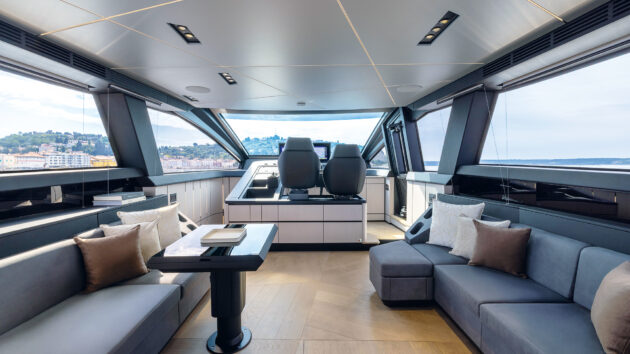
Big single-piece windscreen is a real treat on a boat of this scale
This is three steps up from the beach club to ensure no back wash reaches it but the steps are so wide and shallow it all feels like part of the same space. The only compromise back here is the limited size and access to the side decks.
To free up more width in the saloon, these have been raised up to the level of the gunwales and pushed as far outboard as possible. There are steps leading up to them from the cockpit and they are just about wide enough to shimmy along, but with the guard rails down at ankle height and only a moulded lip to hang onto, they are not for the faint hearted in any kind of swell.
Thankfully, the only reason you’ll need to use them is for cleaning or fender duties as the main access to the foredeck is via a starboard door at the forward end of the saloon. This opens out onto a much wider, deeper, safer section of side deck leading to a generous foredeck lounge with another C-shaped seating and dining station. This has a drop down table and fill-in cushions that expand the already sizeable forward sunbed into one giant sprawlfest.
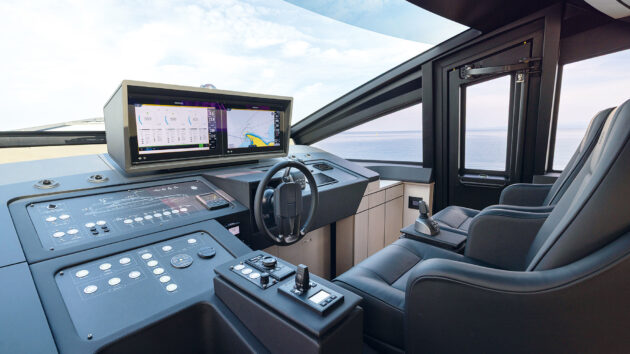
The wrap-around helm makes it feel like you’re piloting a jet fighte
Pump Up the Volume
The benefit of pushing the superstructure out so far is the extra width it allows inside. In some Pershings the long thin shape of the saloon can make it feel like a glorified corridor – not this one. With its surprisingly generous aft galley making full use of the lifting window into the cockpit to create a small bar area between the two, it’s a much more sociable layout than we’re used to.
It’s a similar story further forward where deep L-shaped sofas along both sides encourage interaction. Criss-crossing LED light strips overhead mirror the random patterned floorboards underfoot to create extra visual interest. Handy little recesses in the arms are another neat touch for storing phones, sunglasses and waterbottles, although they’re too big to risk any open drinks. The good news continues below deck, where you’ll find three cabins and three bathrooms.
Article continues below…

Princess S72 review: A sensational new British sportscruiser
£5102782

Pershing 7X yacht tour: This $3.2m sportscruiser can do 50 knots flat-out
The master suite is in the usual midships slot but faces aft rather than forward. The hull windows aren’t as deep as some 70-footers but the light coloured carpets, cabinets and deck head provide some welcome contrast to the dark window surrounds and glossy black aft bulkhead. The forward VIP is a little more quirky, with the bed facing across the beam of the boat towards the port side.
This is to allow room for a small and rather claustrophobic twin bunk crew cabin to be tucked deep into the vee of the bow. The third guest cabin is a twin, again facing across the beam with ensuite access to the day heads, conveniently located at the foot of the stairs. There’s also room for a washing machine on the opposite side of the small lower lobby.
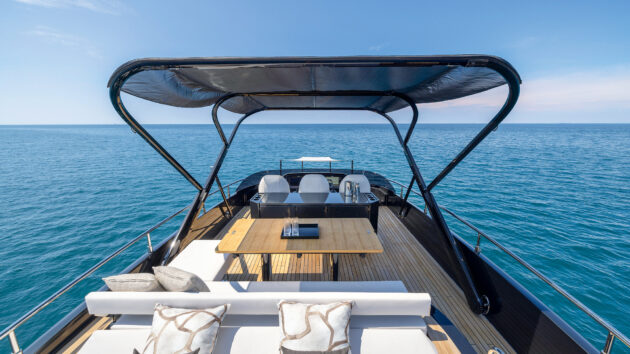
The sportsbridge is surprisingly big and the carbon fibre bimini frame is a genuine work of art
Driving Impressions
Piloting any Pershing is always a momentous occasion, not least because the main helm station makes you feel like you’re in charge of the Battleship Galactica. Positioned bang on the centreline and flanked on one side by your co-pilot and on the other by an imposing bank of dials and switches, it really could be a fighter plane.
The seat itself adjusts electrically and has a huge range of variation, particularly for height so you can perch yourself up high for the best possible view through that immense single-piece windscreen. This does leave the wheel and throttles a fair old stretch away but with Volvo’s latest joystick mounted on the starboard armrest you can control it all with fingertip ease or drop down into the standing position for a more hands-on feel.
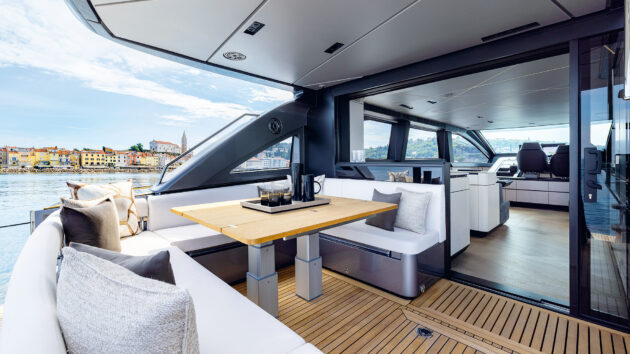
The long overhang can be extended even further with an electric sunshade
The upper helm is an altogether more visceral experience, partly because that aeroscreen isn’t quite tall enough to channel the airflow over your head and partly because being that much higher, you feel the lean more as you dive into a turn.
As an owner operator, that’s definitely where we’d choose to helm from in fine weather to maximise driving enjoyment and feel more connected with your surroundings as well as your guests. Given how well mannered it is under way, you might as well make the most of it. The reason it’s so easy to handle is that instead of two huge 1,800hp MAN V12s linked to a pair of surface drives as per the 50-knot Pershing 7X, the GTX70 is fitted with relatively modest 900hp Volvo D13 six cylinder engines.

The full beam owner’s cabin features a stylish contrast of light and dark colours
However, by fitting three of them and opting for IPS pod drives, it should still be capable of delivering a decent turn of speed without the cost and complication of a bespoke surface drive set-up. By any normal yardstick, it succeeds. Flat out we reached 35.5 knots on test – plenty fast enough for most cruising needs and quicker than the majority of its rivals. It did this without any fuss and zero input from the helm other than easing the throttles all the way forward. It also stayed utterly composed and remarkably refined all the way through the rev range, only nudging past the 70dB mark when it topped 33 knots.
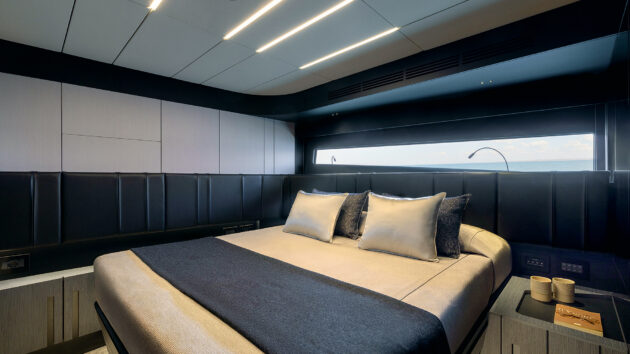
The forward VIP suite faces across the beam of the boat
If anything, it was all a bit too civilised, lacking any of the drama, not to mention the raw speed, that the 7X dishes up in spades. That’s hardly surprising, and not really a fair comparison, but the four-cabin Princess S72 we reviewed back in March 2024 is a more direct rival.
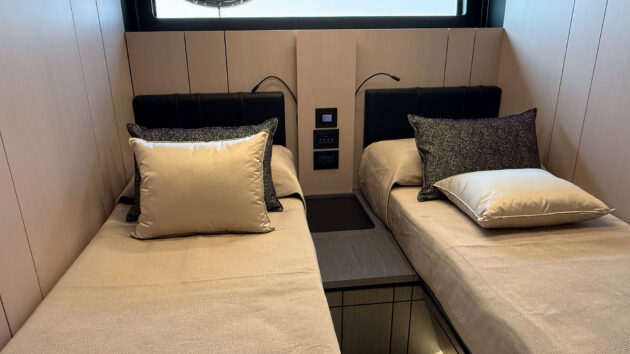
As does the twin bed guest cabin
It reached 38.7 knots during our test in March 2024 with nothing more complicated than a pair of big 1800hp MTUs on straight shafts. The GTX70 does counter with some tidy fuel consumption figures but even on this measure it’s not as clear cut as you might expect. Below 10 knots and above 30 knots the Pershing has a clear advantage due to the smaller size of its engines and the lower drag of its IPS pods, but from 10-28 knots, there’s very little in it – at 27 knots, for instance, both craft are burning around 350lph for a cruising efficiency of 13 litres per mile.
This isn’t a criticism, the GTX70 is still a pleasure to drive and ducks from side to side far more willingly than most 70-footers. In fact, we suspect the hull could cope with a slightly more aggressive steering set-up than the current IPS settings allow in order to sharpen up its responses even further and reduce the size of the turning circle at speed. It’s also a very easy boat to manoeuvre around a marina thanks to the vectoring effect of those big pod drives and Volvo’s intuitive joystick control, which includes a Dynamic Position System to hold you in place regardless of wind or tide.
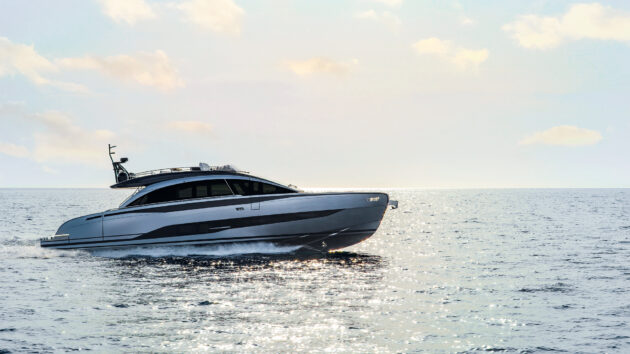
Triple IPS drives make for an effortless if rather undramatic driving experience
Pershing GTX70 specifications
Length overall: 71ft 5in (21.76m)
Beam: 17ft 9in (5.42m)
Fuel capacity: 4,200 litres
Water capacity: 1,000 litres
Draft: 6ft 8in (2.04m) (half load)
Displacement: 52 tonnes (half load)
RCD: Category B for 16 people
Contact: www.pershing-yacht.com
Pershing GTX70 cost and options
Price from: €4.1m ex VAT
 If you enjoyed this….
If you enjoyed this….
Motor Boat & Yachting is the world’s leading magazine for Motoryacht enthusiasts. Every month we have inspirational adventures and practical features to help you realise your sailing dreams, as well as tests and news of all the latest motorboats.
Plus you’ll get our quarterly Custom Yachting supplement where we share the last on offer in the superyacht world and at the luxury end of the market.
Build your knowledge with a subscription delivered to your door. See our latest offers and save at least 30% off the cover price.
Note: We may earn a commission when you buy through links on our site, at no extra cost to you. This doesn’t affect our editorial independence.
>
Verdict
The GTX 70 achieves everything it sets out to do. It looks superb; it has an extensive array of entertaining spaces; it offers three very comfortable cabins and bathrooms; it’s impressively quiet underway and it delivers sufficient performance to honour the Pershing family name while being a refreshingly easy boat to drive and manage. We’d have liked to see it nudge closer to the 40-knot mark and offer a little more reward to the keen driver, but given that Pershing has already got that covered by the 7X, we can hardly complain that the GTX70 offers a different set of priorities. If you’ve always liked the idea of owning a Pershing but been put off by the sheer size, speed or complexity of its larger, more daunting craft, the GTX70 could be just the answer you’ve been looking for


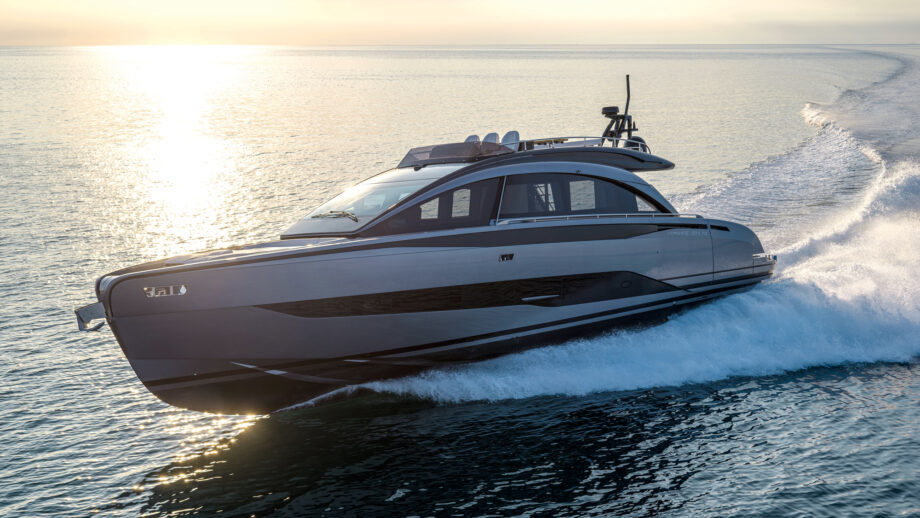
 If you enjoyed this….
If you enjoyed this….